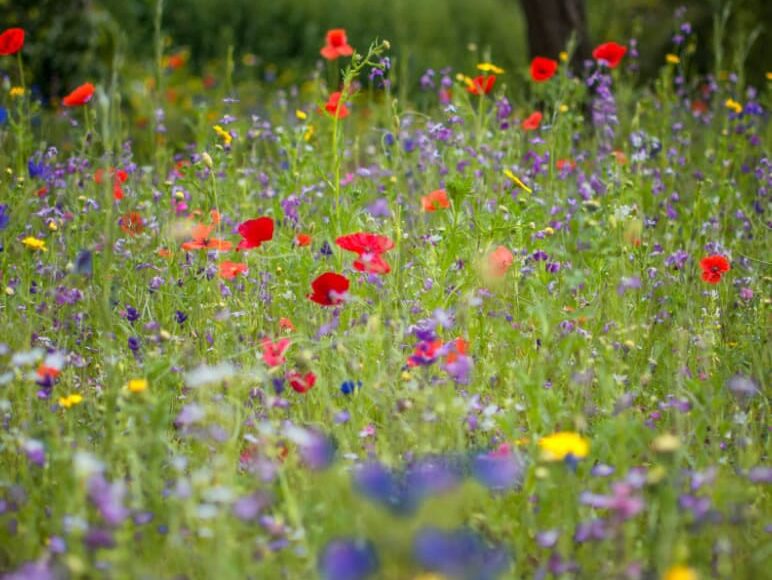Many homeowners dream of creating a beautiful “wildflower meadow” with native blooms to add vibrant colours and visual interest to their landscaping.
While cultivating a wildflower meadow takes a little research, and preparation. To make it work, you need to consider a few basics like soil preparation, plant selection and space management.
In this article, we’ll take a look at how you can use wildflowers to add a pop of colour and charm to your garden, with a focus on native Australian species.

Step 1: Consider your space
Creating a wildflower meadow is totally within reach regardless of whether you have a suburban block or a larger property on acreage. But before you dive in, it’s important to think about the long term.
You may need to be willing to sacrifice one or more grassy areas, which is perfectly fine if they’re not being used. However, if your lifestyle depends on having extensive lawn space, it’s essential to plan around your garden elements accordingly.
You can also consider using a series of large pots if space is limited and you still want to enjoy the beauty of wildflowers in your garden.
Whatever the scale or scope of your wildflower garden, making sure your plants get plenty of sun will help them to thrive.

Step 2: Planting or transplanting?
The first question is whether to create your wildflower meadow or garden by direct planting or by transplanting existing flowers or shrubs.
While transplanting in smaller gardens may be an easy option, the scale of most true “meadow-sized” gardens would make working with pre-grown plants a much more monumental task.
For more expansive gardens, direct seeding is the way to go. Not only is it more practical, but it also allows the plants to establish themselves on their own, resulting in a better root system and less ”transplant shock”. A hand-held spreader (for smaller gardens) or tractor-pulled spreader (for acreage) can be used to assist with seeding.

Step 3: Select your seeds or plants
Plants with height variation and foliage contrast make for a beautiful and balanced visual mix. In contrast, if you prefer a more uniform carpet of wildflowers, choosing fewer species will give you the desired effect.
From Melaleuca, Mint Bush and Myrtle to the beautiful Billy Buttons and Australian Paper Daisy, you’ll find everything you need to know about wildflower plant profiles (and a great selection to choose from) on the Australian Native Plant Society site.
Seed suggestion selection Mix 1. Australian native wildflower mix – Strawflowers, Pink Billy buttons, Native Daisies, Everlasting Daisies, Cottonheads, Blue Flags, some varieties you can use could be : Chrysocephalum apiculatum, the Xerochrysum viscosum and Chrysocephalum semipapposum, Helipterum anthemoides.

Step 4: Prepare the soil
To prepare your garden for planting, clear away unwanted plants and weeds to expose the underlying layer of soil.
Breaking up and turning the soil so that it’s even, and preparing it some weeks before with regular watering, will give the seeds the best chance to successfully germinate and make the ideal surface for your wildflowers to grow.
Wildflower seeds are generally small and lightweight and, when you’re ready to plant, it helps to mix them with some sand and fine soil before spreading them evenly across the prepared soil and watering them in. You can use a seed drill on a tractor for acreage, or a hand seed spreader for smaller spaces. Make sure to mark a grid so you don’t miss any spots.

Step 5: Maintaining your wildflower meadow
While wildflower meadows have a natural and unstructured look, making them seem low maintenance, they do actually need careful planning and continual care.
Give your flowers a chance to grow to a few centimetres in height before feeding or fertilising and wait for them to flourish in the spring and summer.
Many wildflowers will shed their own seeds after flowering, some of which will sprout in the following seasons. For variety, you can clear dried or dead plants in autumn and experiment by introducing new species into the mix.
Need help creating the perfect wildflower meadow?
Are you keen to bring the beauty of wildflowers to your own backyard but not confident of going it alone? Lisa Harper Designs can work with you to plan and create the perfect wildflower meadow for your space.
Book a free discovery call 0493 559 523Resources
Seed resources:
https://anpsa.org.au/plant-guides/australian-native-seed-suppliers/
Indigenous grasses can look wispy and are great for habitat. Kangaroo grass, Wallaby grass, spear grass is particularly dreamy, but a personal choice.
Native flowering species I love are are the Chrysocephalum apiculatum, the Xerochrysum viscosum and Chrysocephalum semipapposum. All available as seed.
A great resource can be found here. https://www.melbourne.vic.gov.au/community/greening-the-city/urban-nature/Pages/urban-nature-planting-guide.aspx
Happy Sowing!

